Nature movies frequently refer to Australia as The Land of Parrots because of how numerous and varied Australian parrots are. In reality, a New World Map from 1564 included the southern continent with this name. That the Australian parrot so charmed the early European explorers is scarcely unexpected. After all, half of the world’s parrot species are found in Australia. Out of the approximately 330 species of parrots on Earth, 57 are found in Australia.
So Why Do Parrots Inhabit Australia in Such Large Numbers?
mostly because the parrots’ seclusion from other big seed-eating birds allowed them to evolve into a wide range of species and spread over the whole continent. Because of this, parrots may be found in most Australian environments, ranging from humid coastal forests to the semi-arid Outback.
What kinds of parakeets are found in Australia?
True parrots (Psittacidae family) and cockatoos (Cacatidae family) are the two types or families of Australian parrots. Large, eye-catching birds with either black or white plumage are cockatoos. True parrots are often smaller and have vibrant colors. They are really some of Australia’s most vivid and colorful birds.
Here are 57 different species of Australian Parrots:
Budgerigar
- Latin name: Melopsittacus undulatus
- Conservation Status: Least Concern
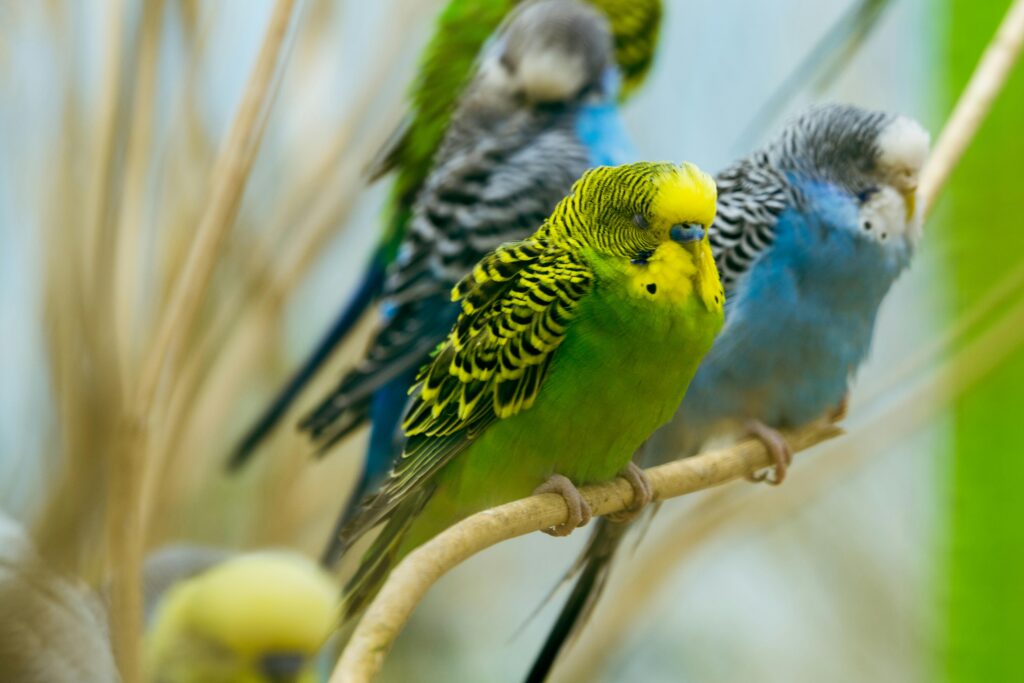
Budgerigars are native to much of the Australian interior west of the Great Dividing Range and are arguably the most well-known of all Australian parrot species.
Nomadic parrots, budgies go from one location to another in pursuit of food and water. They mostly eat grass seeds in their preferred open settings. Although they usually travel in tiny flocks, they occasionally come together in large flocks that number in the thousands.
Typically, they have been spotted in the Simpson Desert, Uluru, and the Western MacDonnell Ranges in the Red Center.
Australian Cockatoos
Large, long-lived parrots with a feathered crown over their heads are called cockatoos. Australia is home to 14 of the 21 species of cockatoos worldwide (the other species are found in Papua New Guinea, Indonesia, and the Philippines).
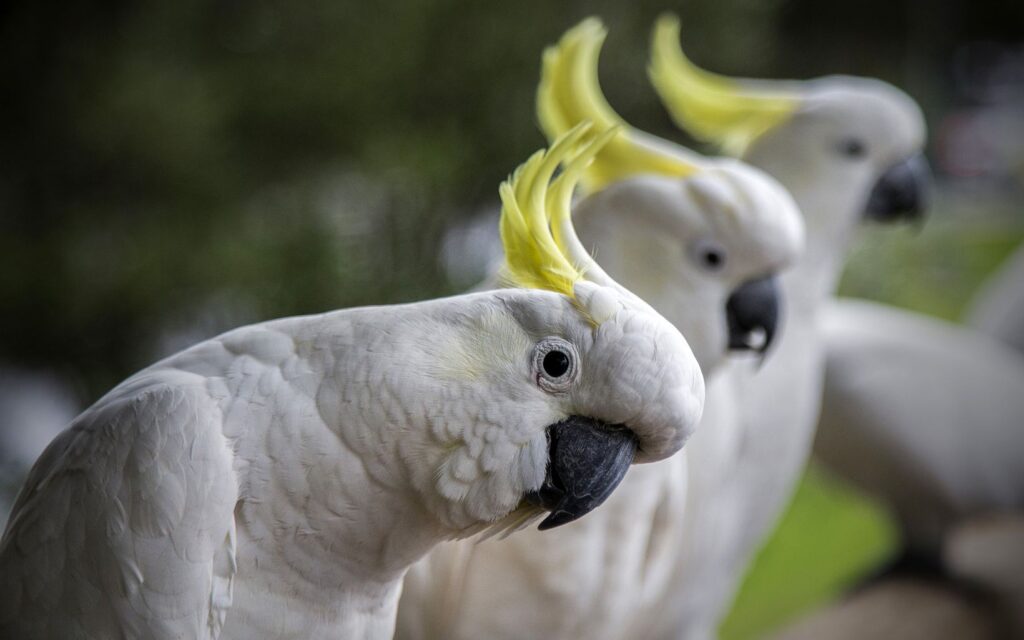
Generally speaking, they lack the smaller parrots’ vibrant colors. There are eight Australian cockatoo species: two are pink, six are black, four are white, and the other two are multicolored.
Since all Australian cockatoos nest in tree hollows, huge, ancient trees must be present in the landscape in order to offer the hollows big enough for the birds to nest in. Thus, the main danger to Australian cockatoos’ continued existence is the country’s loss of old-growth forests.
Palm cockatoo
- Latin name: Probosciger aterrimus
- Conservation Status: Least Concern
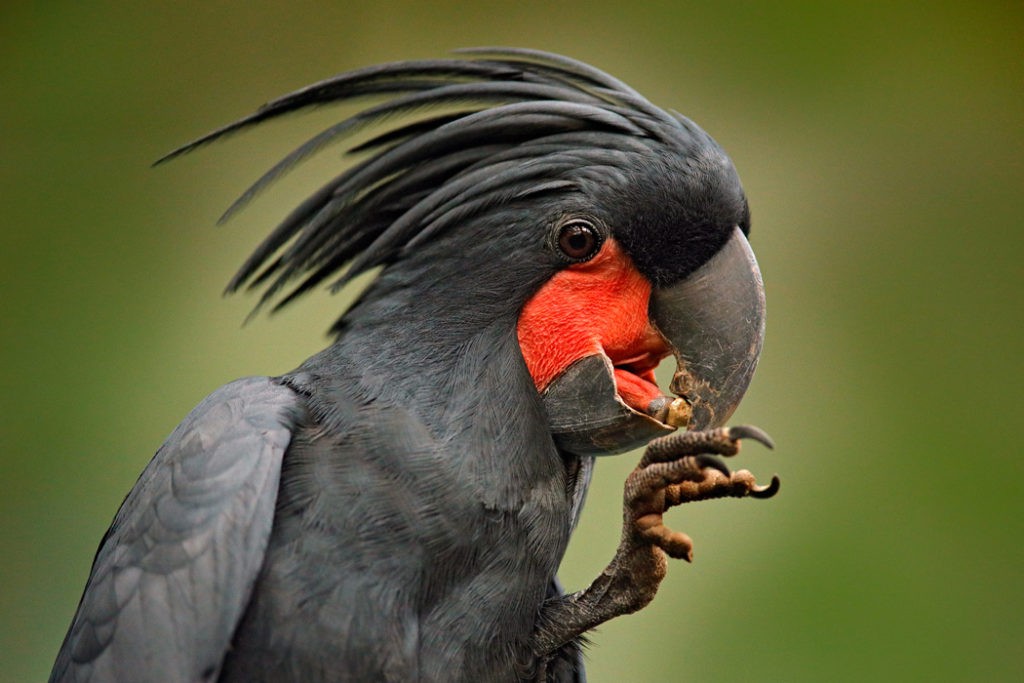
The Palm Cockatoo is the most distinctive Australian parrot due to its massive size, black plumage, red cheeks, and tall crest. These majestic birds may reach lengths of 55 to 60 cm and weights of up to 1.2 kg. One of the very few bird species known to utilize tools is the palm cockatoo, which is native to the Cape York Peninsula (as well as New Guinea).
Male palm cockatoos make a loud noise by drumming huge sticks and seed pods against a dead tree during the mating season. The enigma behind the palm cockatoo’s drum. Typically, palm cockatoos wander in groups of four to six birds or in pairs. In Iron Ranges National Park, you are most likely to spot them soaring above the canopy.
Red-tailed black cockatoo
- Latin name: Calyptorhynchus banksii
- Conservation Status: Least Concern
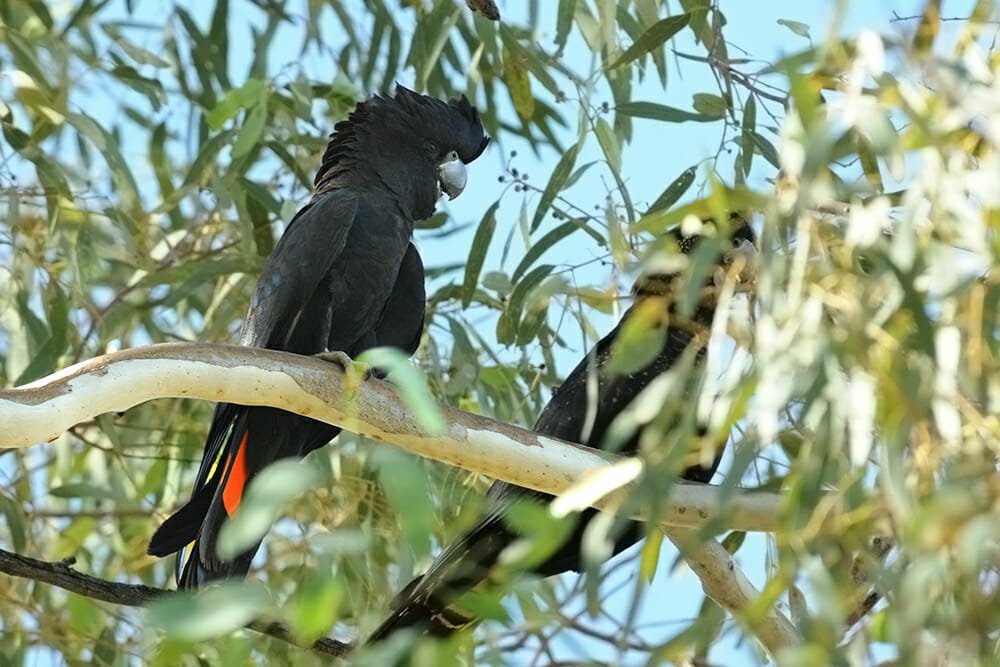
The red-tailed black cockatoo is a gorgeous huge parrot with black plumage that may grow up to 60 cm in length. The underside of the tails of male birds are striped with two vivid red bands. They are more prevalent in Australia’s northern regions, where they like eucalypt woods.
While traveling from Adelaide to Darwin, I saw them all over the north, in places like Katherine Gorge, Old Andado, and the West Macdonnell Ranges. They’re also seen in Perth’s inner regions. Large flocks of these eye-catching birds frequently gather, particularly near water supplies.
Glossy black cockatoo
- Latin name: Calyptorhynchus lathami
- Conservation Status: Least Concern

The Glossy Black Cockatoo, the smallest of the black cockatoo species (measuring around 50 centimeters in length), is mostly found in eastern Australia, ranging from southeast Queensland to eastern Victoria. There’s a good possibility you’ll spot them around the Tweed shoreline.
The greatest spot to observe this species in the wild may be on Kangaroo Island in South Australia, where there is also an outlying population.
This cockatoo’s body is black, and its head is dark brown. Moreover, the tails of males feature two red panels. They often inhabit areas of open forests, where they consume the seed pods of Casuarina trees.
Yellow-tailed Black Cockatoo
- Latin name: Zanda funerea
- Conservation Status: Least Concern

Large and growing to a length of 55–60 cm, the Yellow-tailed Black-Cockatoo is a parrot native to southeast Australia, ranging from the Eyre Peninsula in South Australia to central and southern Queensland. Their tail panels and vivid yellow cheeks stand out against their uniform black plumage.
There are a lot of these cockatoos in and around Sydney. The greatest locations to view them are the southernmost parks, Royal National Park and Centennial Park. The yellow-tailed black cockatoo is a loud flock bird that usually travels in large groups to feast on the seed pods of native Australian trees. In Narooma, we have observed several sizable flocks.
Baudin’s Black Cockatoo
- Latin name: Zanda baudinii
- Conservation Status: Endangered

The 56 cm-long Baudin’s Black Cockatoo, also known as the Long-billed Black Cockatoo, is a big parrot with uniform black plumage with white cheek and tail panels. It is native to Australia’s southwest, but tragically, its population is dwindling there.
Experts estimate that the wild population of Baudin’s black cockatoos ranges between ten to fifteen thousand individuals, with the species classified as critically endangered by the IUCN in 2021. According to information from the Kaarakun Black Cockatoo Conservation Centre, these birds are primarily found in regions extending from north Gidgegannup to east Wandering, and as far west as Midland, Gosnells, Byford, and Bunbury, with sightings reported further south in Margaret River, the Stirling Ranges, and Porongorup Ranges. They exhibit a preference for habitats characterized by dampness and dense forests.
Carnaby’s Black Cockatoo
- Latin name: Zanda latirostris
- Conservation Status: Endangered

A similar-looking endemic to Baudin’s black cockatoo is Carnaby’s black cockatoo, which is found in southwestern Australia. It is sometimes referred to as the Short-billed Black Cockatoo, because its shorter bill sets it apart from its relative. It might be difficult to distinguish between the two species in the wild.
Large hollows in ancient eucalypt trees are home to Carnaby’s cockatoo nests. Additionally, the population of this species is declining because old-growth forests are decreasing throughout Australia. The Gnangara pine forest in northern Perth and the 30-km-wide Swan Coastal Plain to the north of Perth are suitable places to search for this species.
Gang-gang Cockatoo
- Latin name: Callocephalon fimbriatum
- Conservation Status: Least Concert

Gang-gang is a cute little cockatoo with vivid red heads and crests on male birds and gray plumage. Gang-gang is endemic to the coastal areas of southeast Australia; it loves woods and forest settings. They travel to lower elevations and more open environments in winter, but they spend the most of the year in the highlands, where they reproduce in the hollows of eucalypt trees.
Cockatiel
- Latin name: Nymphicus hollandicus
- Conservation Status: Least Concern
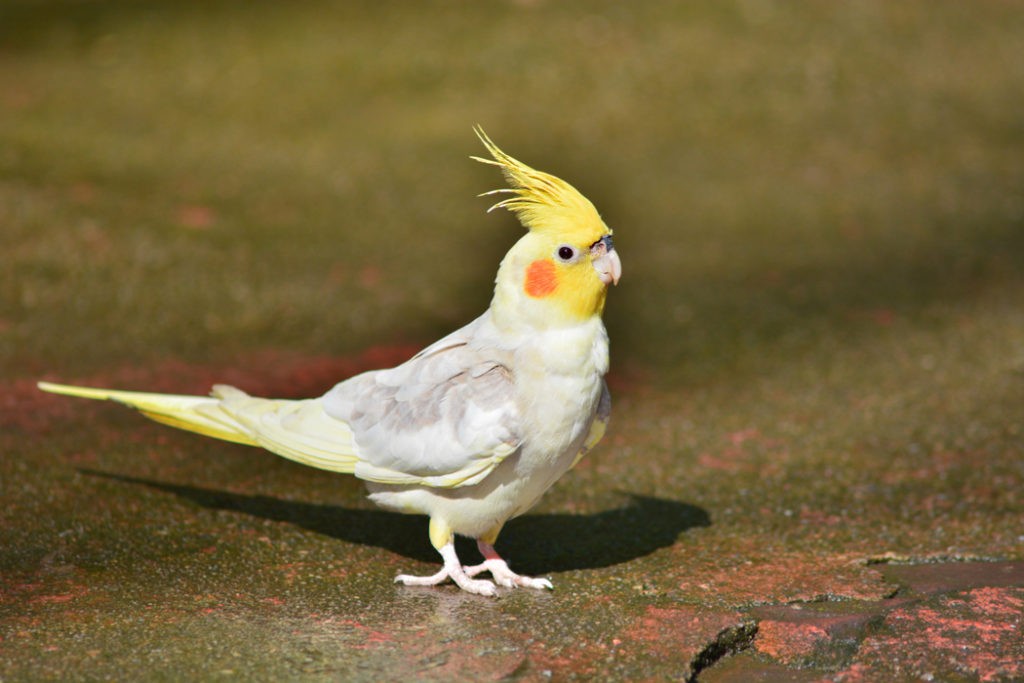
The tiniest bird in the cockatoo family is the cockatiel. It is a little, thin bird that, until recently, was a member of the family known as “true parrots.” Its stunning golden crown and long tail set it apart.
The arid and semi-arid parts of Australia are home to the majority of cockatiels, which have a migratory existence based on the availability of food and water. They migrate largely in tiny flocks, however they occasionally gather in big groups around water sources.
Sulphur-Crested Cockatoo
- Latin name: Cacatua galerita
- Conservation Status: Least Concern

The Sulphur-created cockatoo, with its dazzling yellow crest and snow-white plumage, is arguably the most recognizable bird in Australia and is inextricably linked to pirates and lost wealth. These big cockatoos, known as the pranksters of the parrot world, are common over much of the eastern seaboard, extending from the Kimberley to Tasmania.
They frequently appear like regal jesters as they descend with a laud clamor, bending their heads and erecting their crests.
Long-Billed Corella
- Latin name: Cacatua tenuirostris
- Conservation Status: Least Concern

It is only lately that the two species of Long-billed corellas—Western corellas in the west and Long-billed corellas in eastern Australia—were distinguished from one another. The eastern Long-billed Corella has an eye ring that is distinctly pale blue, and its plumage is entirely white with brilliant red-orange splashes on its face and throat. These striking birds are found throughout southeast Australia and like grassy areas, such as parks in cities.
Sydney was not formerly part of their habitat, but due to ongoing habitat modification, the birds’ range is expanding and they are now frequently spotted in Sydney’s suburbs. The Blue Mountains, including the Euroka clearing, Kur-rin-gai Chase, and Royal National Park campsites are ideal areas to watch both kinds of Corellas.
Western Corella
- Latin name: Cacatua pastinator
- Conservation Status: Least Concern
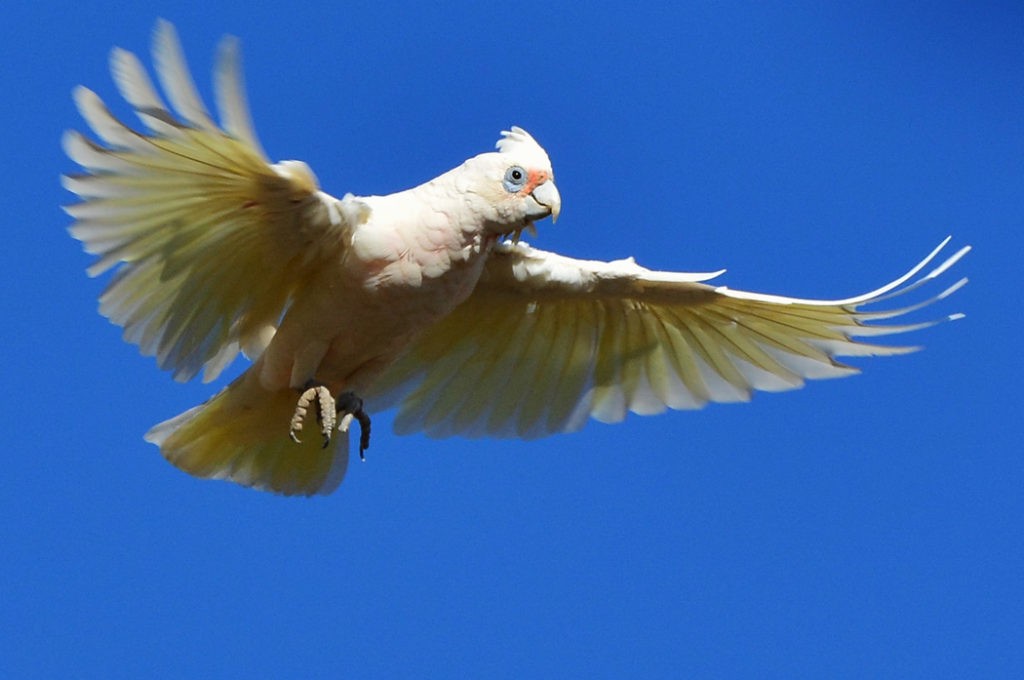
The Eastern long-billed corella has a striking resemblance to its Western counterpart. They are widespread in southern Australia, where during the summer they frequently gather in large flocks to look for water and food. Moreover, they may frequently be heard from a significant distance away due to their gregarious social nature.
Little Corella
- Latin name: Cacatua sanguinea
- Conservation Status: Least Concern

The Little corella is the smallest of the three species, sharing a similar appearance with the two Long-billed corella species. It doesn’t have a crimson neck, and its bill is proportionate.
The fact that Little Corellas like playing is what makes them so fascinating. I saw them fly back to the top and slide again after sliding down the roof of an Old Andado rain tank. According to Birdlife Australia, they could be seen “spinning round and around, falling off and then regaining a precarious grip on the blades” as they rode the windmill blades.
A few years ago, they used to gather in big flocks in Sydney, smashing the seed pods of city trees and leaving a crunchy layer of twigs and pods on sidewalks used by pedestrians. When they fight with Sulphur-crested cockatoos, who are even more at home in the city, they stand out the most.
Galah
- Latin name: Eolophus roseicapilla
- Conservation Status: Least Concern

They travel in tiny groups most of the time, but occasionally they will gather in large flocks of up to a thousand individuals. These flocks may include a variety of species, such as Major Mitchell, Sulphur-created cockatoos, and Little corellas. They are frequently spotted in parks and suburban areas of Sydney.
The Galah is a calmer, kinder bird than the majority of Australian cockatoos. Its light grey back, wings, and tail, together with its pink face, breast, belly, white crown, and light pink crest, are all beautifully subdued in its plumage. It is among the most widely distributed cockatoos in Australia.
Major Mitchell’s Cockatoo
- Latin name: Lophochroa leadbeateri
- Conservation Status: Least Concern
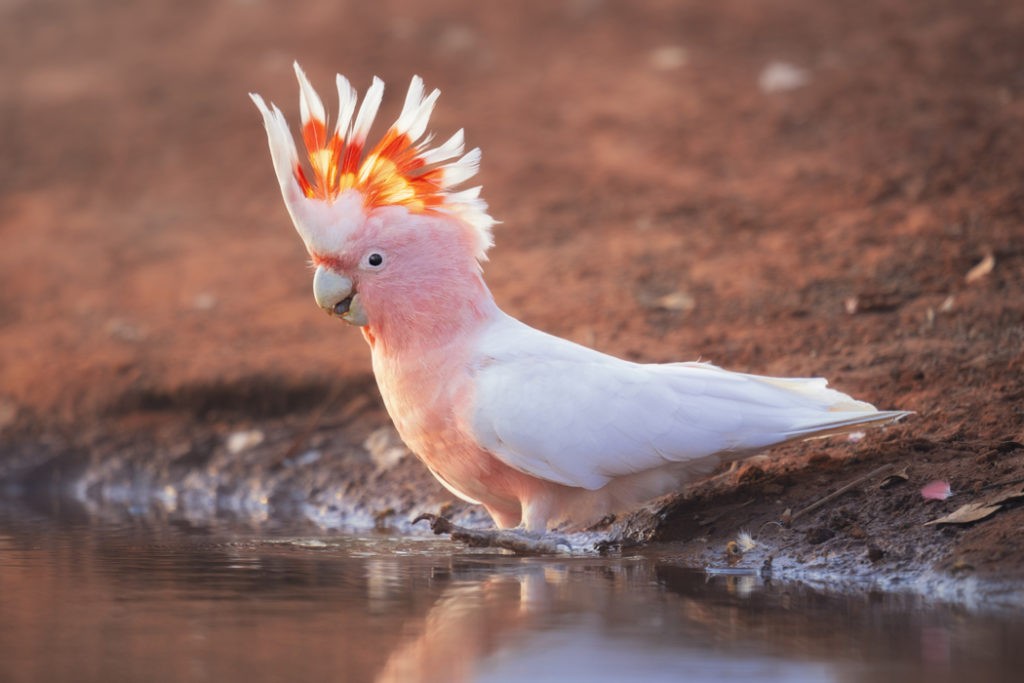
One of the most attractive cockatoos in Australia is the Major Mitchel kind. Its face, neck, breast, and belly are salmon pink, giving it a cockatoo-like appearance. Its stunning crest, with vivid bands of yellow and red, is what makes it so unique.
It is found in much of Australia’s arid and semi-arid areas.
Australian Parrots
The True parrot family includes the remaining Australian parrots. The majority of these birds are incredibly colorful, having adapted to live in nearly every kind of environment, from beaches and deserts to tropical rainforests and alpine forests.
The enormous but thin Australian King-parrot, the heavy-set Eclectus parrot, and the small Double-eyed Fig-Parrot and Little Lorikeet are examples of Australian real parrots. The majority of these species consume insect larvae, seeds, and nectar.
Rainbow Lorikeet
- Latin name: Trichoglossus moluccanus
- Conservation Status: Least Concern
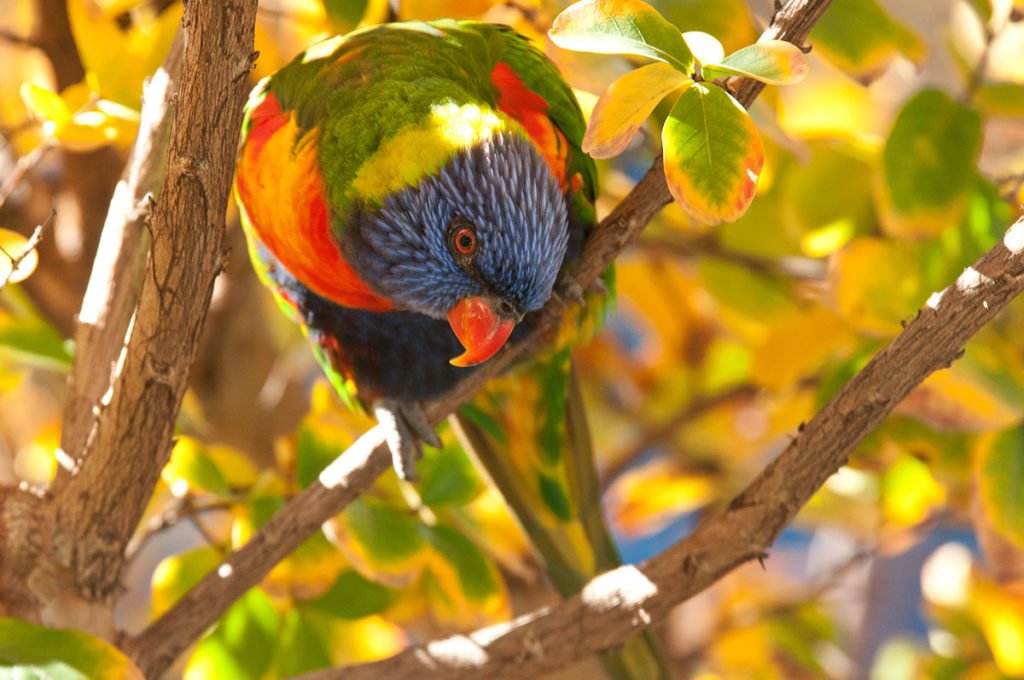
A vivid and noticeable lorikeet that blended in nicely with the urbanization process. From northern Queensland to South Australia, the eastern seaboard is home to this common species. Although forests and woodlands are its preferred habitat, it is equally at home in most towns across its range.
Small flocks of rainbow lorikeets fly together to feed on pollen and other fruits, seeds, and insects. They outcompete other parrot species in urban settings and are ostentatious birds. Rainbow lorikeets may be found in Sydney anywhere there are blooming plants.
Red-collared Lorikeet
- Latin name: Trichoglossus rubritorquis
- Conservation Status: Least Concern

The Red-collared Lorikeet may be identified from the Rainbow lorikeet by the red band on the back of its neck. This species is found in Northern Australia, where they seem to be at ease in towns but also enjoy wooded areas. Similar to Rainbow lorikeets, these birds are noticeable and often fly in couples or small flocks while chirping loudly.
Scaly-Breasted Lorikeet
- Latin name: Trichoglossus chlorolepidotus
- Conservation Status: Least Concern

This species has a scaly look because to its yellow breast and green-edged belly. They are widespread along Australia’s eastern coast’s wooded areas. Since they feed high in the canopy, rainbow lorikeets can sometimes be overlooked in places where they are common. Additionally, their predominantly green plumage helps them blend in well with the verdant foliage.
You are likely to hear scaly-breasted lorikeets more often than see them since they travel in loud, tiny flocks.
Varied Lorikeet
- Latin name: Psitteuteles versicolor
- Conservation Status: Least Concern

The varied lorikeet is distinguished by its striking red head and mostly green plumage with yellow streaks. It lives nomadic, following the blossoming season of its favorite trees, in tropical forests and grasslands across northern Australia, from northern Queensland to the Northern Territory and Western Australia.
They move in big groups and may act aggressively toward neighboring species that are eating. While still quite numerous in the western portion of its habitat, this species is becoming less frequent in the eastern portion.
Musk Lorikeet
- Latin name: Glossopsitta concinna
- Conservation Status: Least Concern

A lorikeet that is mostly green with noticeable red spots on its ears and forehead. It is widespread in southeast Australia, where it is more prevalent in dry woods and woodlands, while metropolitan parks are also frequently home to it.
Large flocks of Musk lorikeets can gather, especially in the tops of blooming eucalypt trees, where they frequently interact with Rainbow lorikeets. Mt Annan Botanic Garden in Sydney is a fantastic place to view them, since they make their nests in the hollows of big trees that grow just past the garden’s entrance.
Little Lorikeet
- Latin name: Parvipsitta pusilla
- Conservation Status: Least Concern

With a maximum length of about 15 centimeters, the little lorikeet is among the tiniest parrots found in Australia. Its face is crimson and its plumage is predominantly green. This species, which lives in forests, is found throughout eastern and southern Australia.
The Little Lorikeet is difficult to spot due to its small size among the large, often twice as large, green foliage. They travel in tiny groups and gather in greater numbers in the trees that bloom.
Purple-Crowned Lorikeet
- Latin name: Parvipsitta porphyrocephala
- Conservation Status: Least Concern

A little lorikeet with predominantly green plumage that is identified by its light blue chin, breast, and abdomen, its yellow-orange forehead and ear-coverts, and its dark purple crown. It may be found on Kangaroo Island and southern South Australia as well as southwest Western Australia.
Purple-crowned lorikeets are nomads in bloom, much like many other lorikeet species. They travel in tiny groups, following their favorite trees’ blossoming seasons. But as soon as they discover a plentiful supply of nectar, they frequently gather in mixed flocks with musk and rainbow lorikeets.
Double-eyed Fig-Parrot
- Latin name: Cyclopsitta diophthalma
- Conservation Status: Least Concern
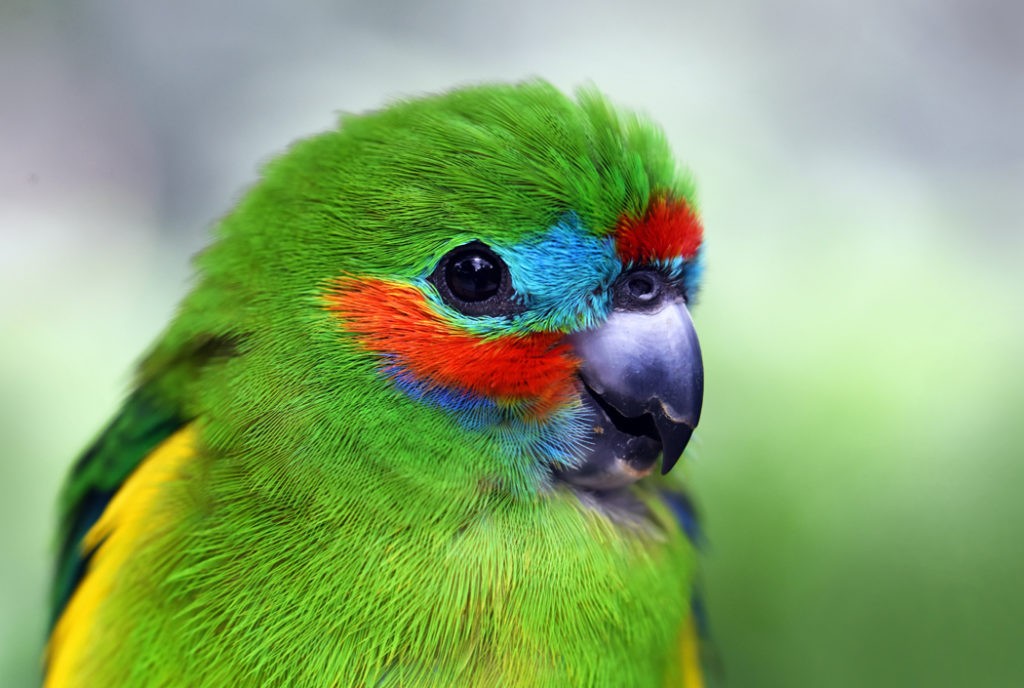
The smallest parrot in Australia is the Double-eyed fig parrot, which reaches a length of about 14 centimeters. With turquoise eye patches, crimson cheeks, and a red mark on its forehead, it has an extremely attractive face. Primarily found in New Guinea, it has also spread to northern NSW and Far North Queensland, namely in the Richmond River area.
The Coxen’s fig parrot, a NSW subspecies, is classified as Critically Endangered in the state, despite the species’ Least Concern status. Fig parrots forage for figs, berries, seeds, nectar, and insect larvae by moving in pairs or small flocks.
Eclectus Parrot
- Latin name: Eclectus roratus
- Conservation Status: Least Concern
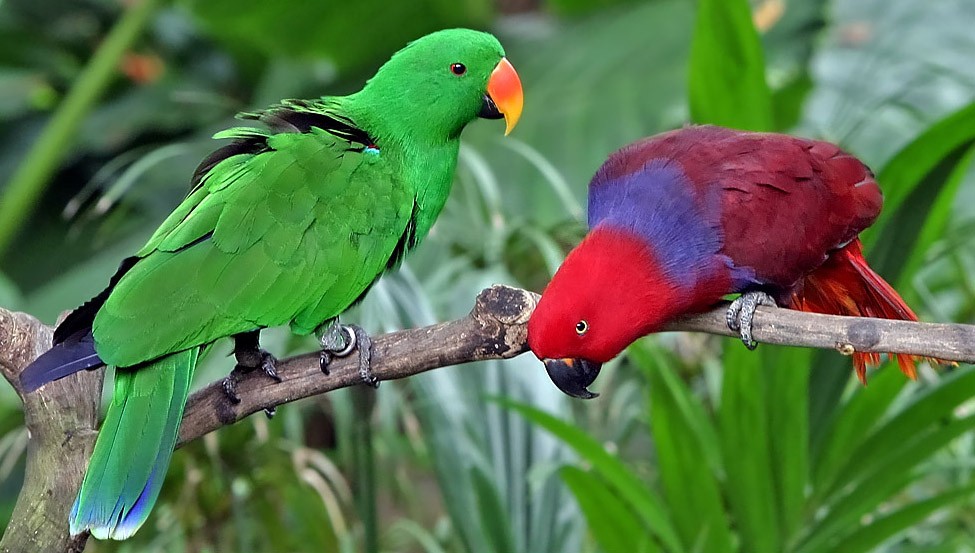
The male and female Eclectus parrots have distinct appearances, suggesting that they are members of distinct species. The female is bright red, while the male is emerald green. When these loud-calling, visible birds fly or eat on the rainforest canopy, they make a lot of noise.
Eclectus parrots inhabit the rainforest and surrounding eucalypt forests in the northeastern part of Australia.
Red-cheeked Parrot
- Latin name: Geoffroyus geoffroyi
- Conservation Status: Least Concern
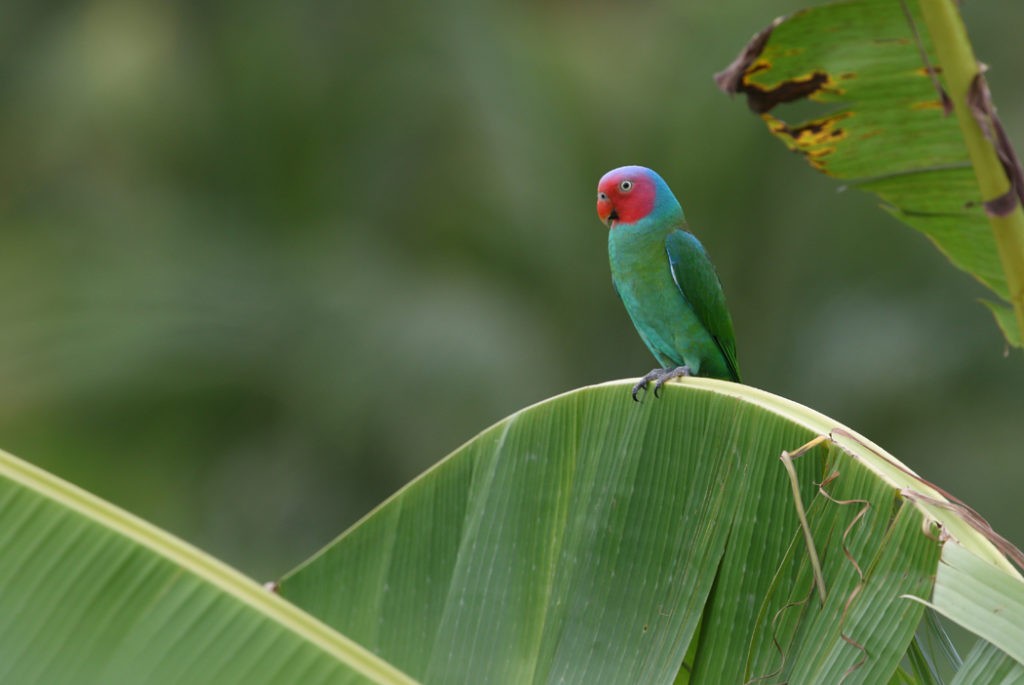
Beautiful red-cheeked parrots may be seen on the Cape York Peninsula. It favors mangroves, wet lowland forests, and dry woods found in tropical and subtropical regions. Typically, these birds reside in tiny family groups or couples. However, when they are figs, seeds, blooms, and nectar-feeding, they can congregate in loud, noticeable numbers. Because they are not very good walkers, these parrots are rarely seen on the ground.
Australian King-Parrot
- Latin name: Alisterus scapularis
- Conservation Status: Least Concern
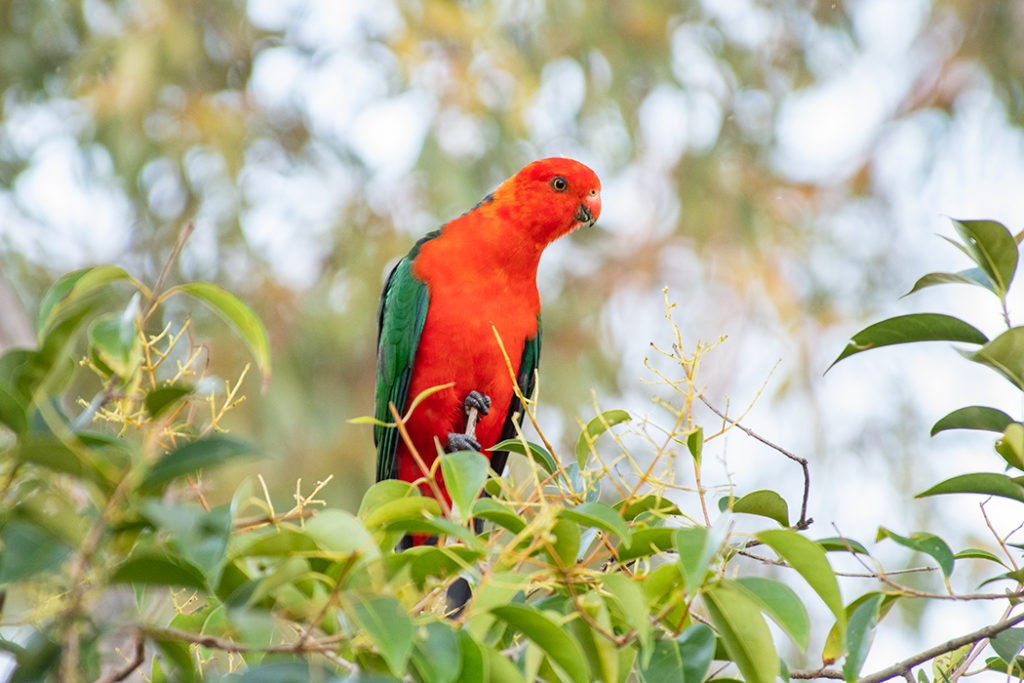
The King parrot, the biggest real parrot in Australia, is indigenous to the coast and mountain ranges of eastern Australia, extending from Port Campbell in Victoria to Cooktown in Queensland. Its preferred habitats are moist sclerophyll woods and rainforests, where it feeds on fruit and seeds.
In the Sydney area, Dangar Island on the Hawkesbury River, Kangaroo Valley, and Green Patch in Jervis Bay are excellent locations to observe King parrots. Warrumbungles National Park is an excellent site farther inland.
Red-Winged Parrot
- Latin name: Aprosmictus erythropterus
- Conservation Status: Least Concern
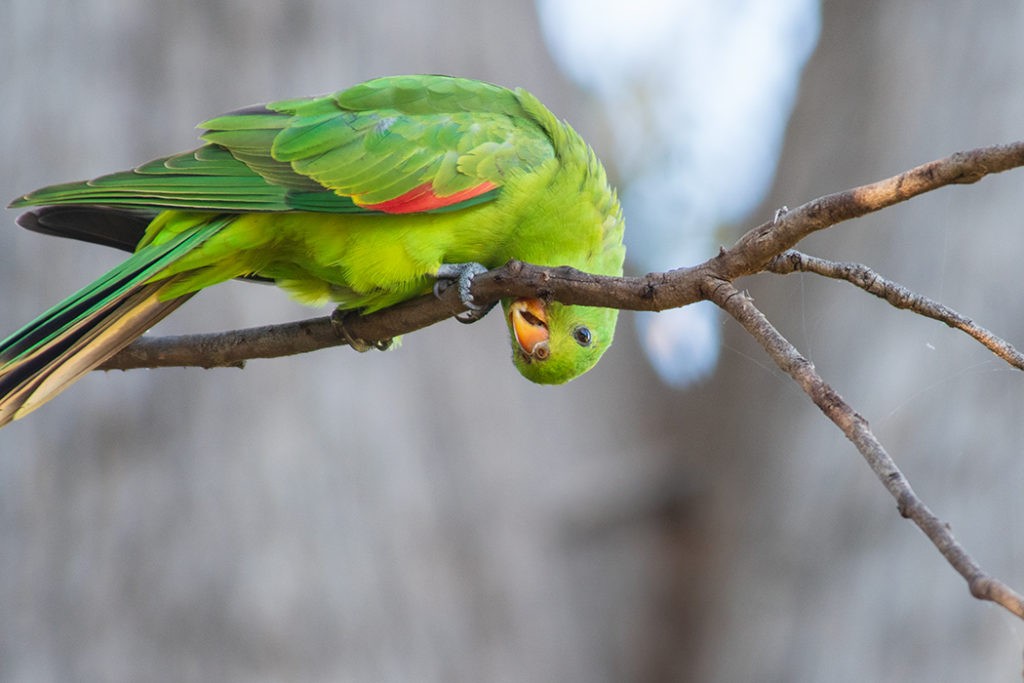
The Red-winged parrot is found in eastern and northern Australia. It favors open environments such as meadows, scrublands, dry forests, and wooded riverbanks. These parrots reside in tiny flocks or pairs. They often forage high in the canopy, on seeds, berries, blooms, and nectar.
In the Northern Territory, which includes Katherine Gorge and Kakadu National Park, they are a regular sight. Warrumbungle National Park in New South Wales is a wonderful spot to watch them.
Superb Parrot
- Latin name: Polytelis swainsonii
- Conservation Status: Least Concern
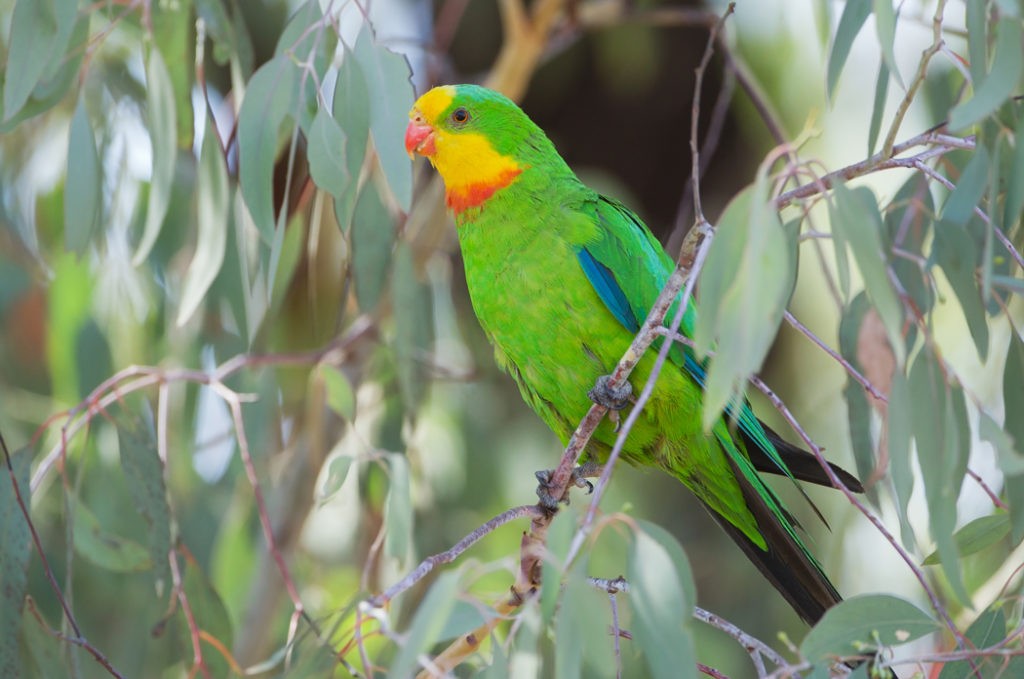
Southeast Australia is home to the unique Superb parrot. It may be found in Victoria, the Riverina region of New South Wales, and the northern part of the state during the winter. It is unique among parrots in that it travels every day between its eating grounds in the nearby riverine plains and its breeding locations along inland rivers amid river red gums. Every day, they travel between their breeding and feeding grounds, where they occasionally get together in sizable groups of thirty birds or more.
Along the Murrumbidgee River, which runs from Wagga Wagga west to Carrathool, is an excellent spot to look for them. The Murrumbidgee Valley National Park’s river red gums are home to the bulk of their known nesting locations.
Regent Parrot
- Latin name: Polytelis anthopeplus
- Conservation Status: Least Concern

Australia is home to two populations of Regent parrots. Three areas in Australia: one in the Murray Mallee region of South Australia, one in northwest Victoria, one in southwest New South Wales, and one in southwest Western Australia.
Regent parrots travel in pairs or gather in groups of approximately twenty birds. They graze mostly on grass seeds while on the ground.
Princess Parrot
- Latin name: Polytelis alexandrae
- Conservation Status: Near Threatened
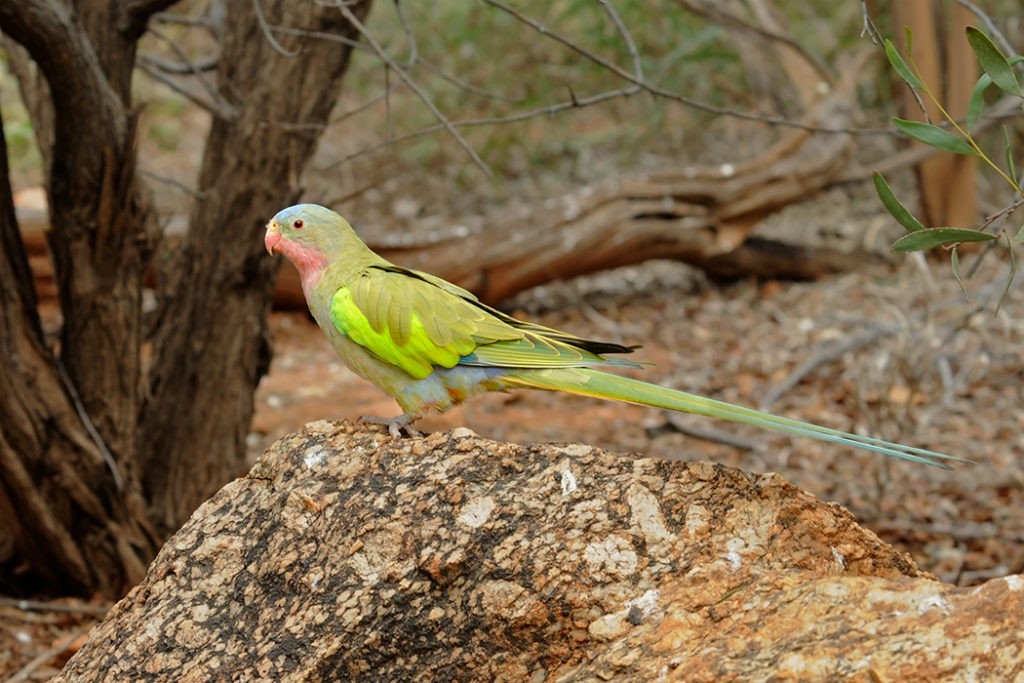
The desert species known as the princess parrot is extensively found in South Australia, the Northern Territory, and Western Australia’s interior. One of the least recognized parrot species in Australia is this secretive itinerant species. They are known to engage in mobbing behavior against predators, which sets them apart from most other parrot species.
Green Rosella
- Latin name: Platycercus caledonicus
- Conservation Status: Least Concern
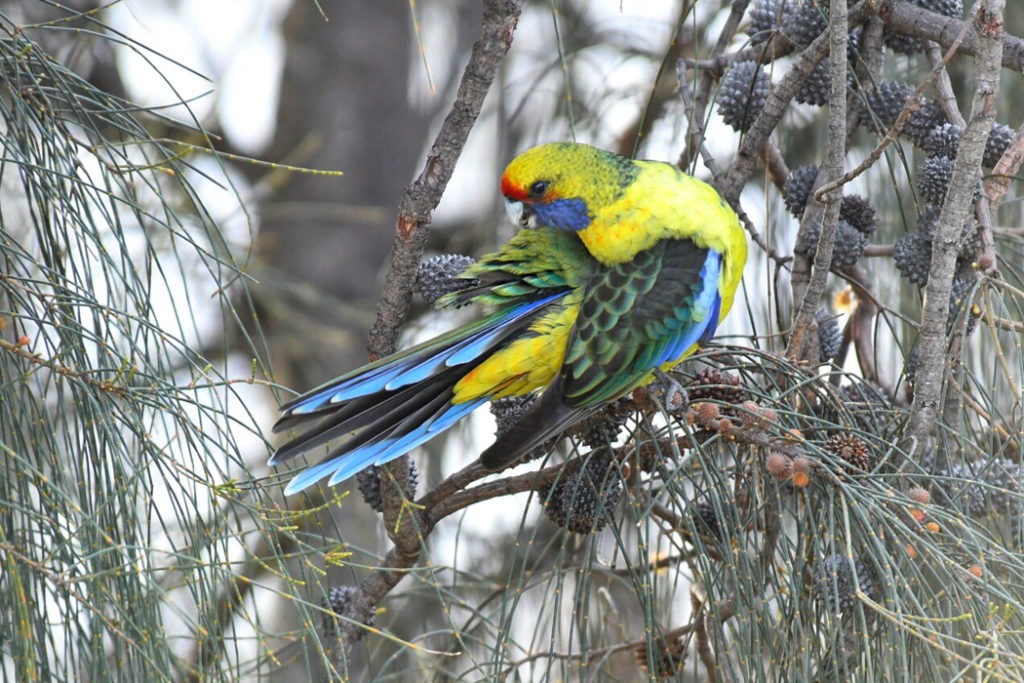
The biggest rosella species in Australia is the green rosella, which is the sole indigenous species in Tasmania. It is distributed all throughout Tasmania in all types of woodland habitats, where it feeds on the larvae of insects, fruits, berries, seeds, and nectar.
Green rosellas may be seen at Cradle Mountain and Bruny Island. They may even be seen in the mountains during the winter when a layer of snow covers the surroundings.
Crimson Rosella
- Latin name: Platycercus elegans
- Conservation Status: Least Concern
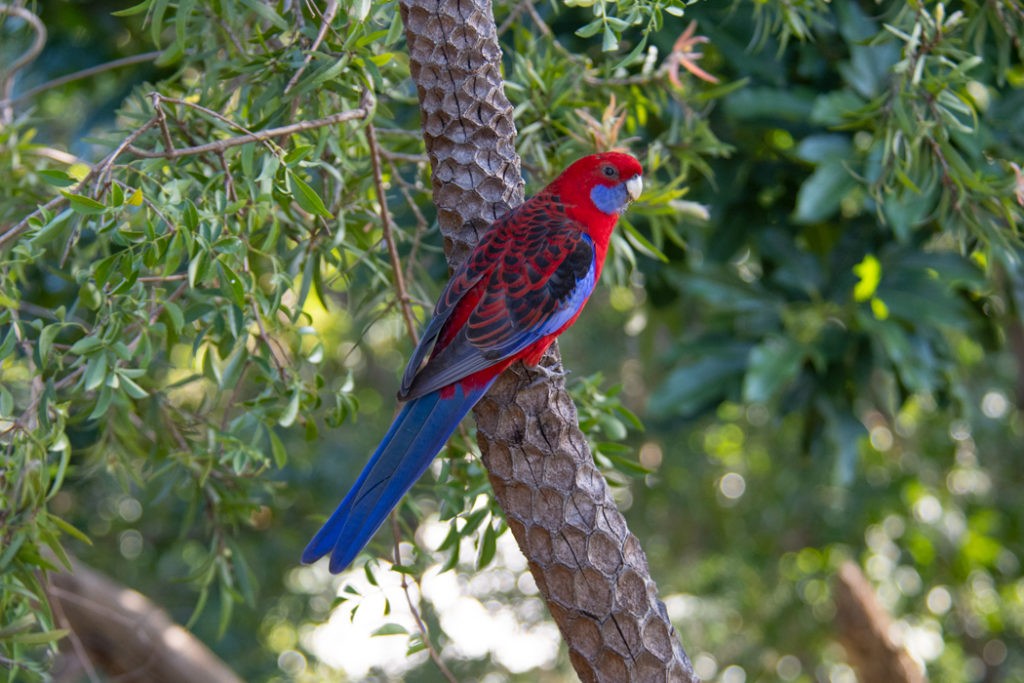
Actually, red rosella, the most vivid kind, isn’t usually crimson. Red rosellas are yellow, black, and blue in the outback of NSW near the Murray River, while they are in between crimson and yellow in South Australia.
In general, the species is found across southeast Australia. From northern Queensland to South Australia, including Kangaroo Island, red-winged swallows may be found. They are frequently spotted in and around Sydney, especially in Royal Park. You may also view them at Kangaroo Valley, especially at the Cambewara Mountain outlook.
The Flinders Ranges is home to orange birds, whereas the Murray and Murrumbidgee rivers are home to yellow birds. This species is highly visible since it forages on grass seeds on the ground, where it is frequently seen.
Eastern Rosella
- Latin name: Platycercus eximius
- Conservation Status: Least Concern
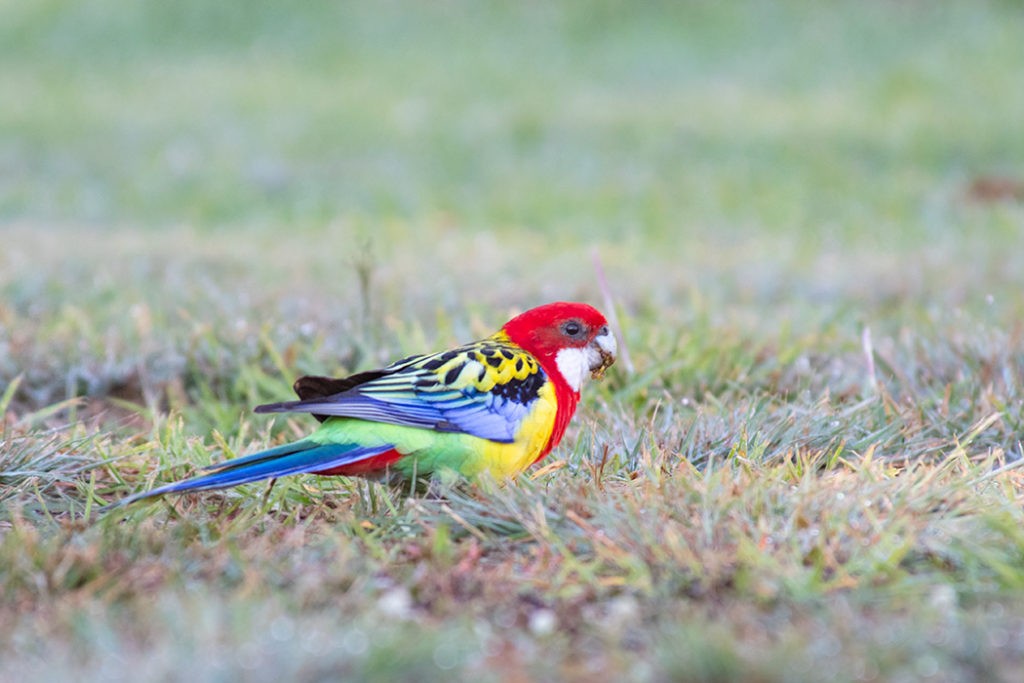
Native to eastern Australia, including Tasmania, is the eastern rosella. It may be found in urban parks, farmlands, open forests, and meadows where it mostly grazes on the ground. These striking birds typically migrate in couples and mate for life.
Sydney’s parks, from Mount Annan Botanic Gardens in the west to Centennial Park in the city center, are often home to them.
Pale-headed Rosella
- Latin name: Platycercus adscitus
- Conservation Status: Least Concern

The pale-headed rosella is predominantly found in Queensland, ranging in color from the Cape York Peninsula to Cardwell in the state’s central region.
It might be difficult to identify Pale-headed rosellas due to their colorful plumage that blends in surprisingly well with the green leaves. Their preferred habitats are grassy understory forests and savanna woodlands, where they mostly forage on the ground.
Northern Rosella
- Latin name: Platycercus venustus
- Conservation Status: Least Concern
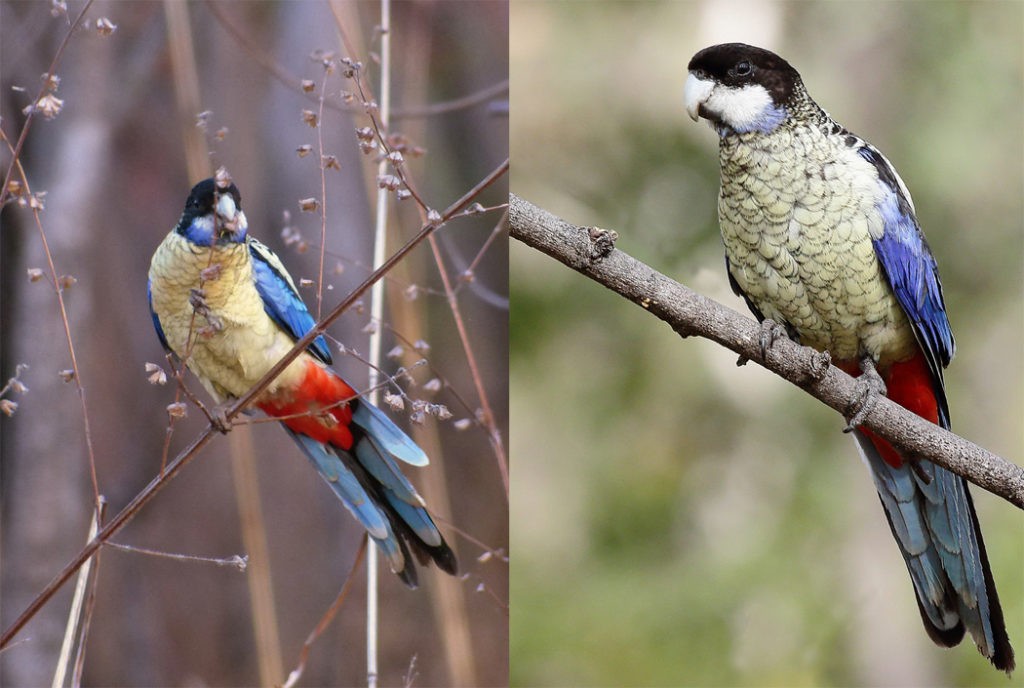
Northern rosellas are found in northern Australia, as its name implies. It’s a very evasive and timid rosella that takes off quickly when startled. It consumes grass seeds, eucalypt seed, flowers, and berries while living in grassy open forests, woods, and savannas.
Western Rosella
- Latin name: Platycercus icterotis
- Conservation Status: Least Concern
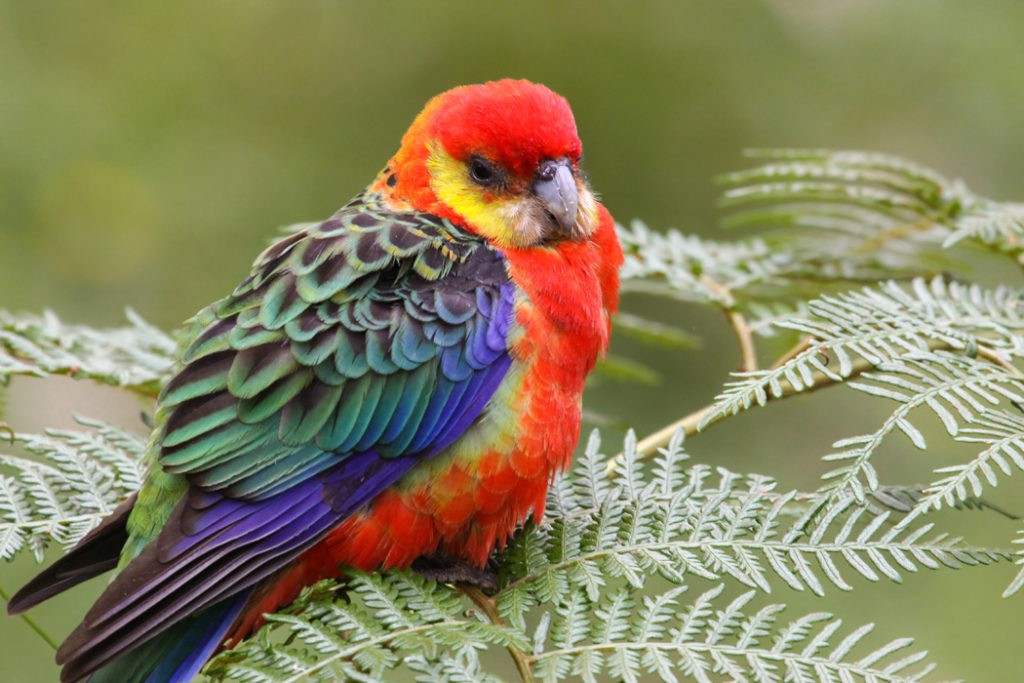
Only the southwestern region of Australia is home to the Western rosella, the smallest species of rosella. It feeds mostly on the ground, like all other rosellas, eating grass seeds, fruits, blossoms, and insect larvae.
Normally seen in pairs or small family groups, Western Rosellas gather in tiny flocks throughout the winter.
Australian Ringneck
- Latin name: Barnardius zonarius
- Conservation Status: Least Concern
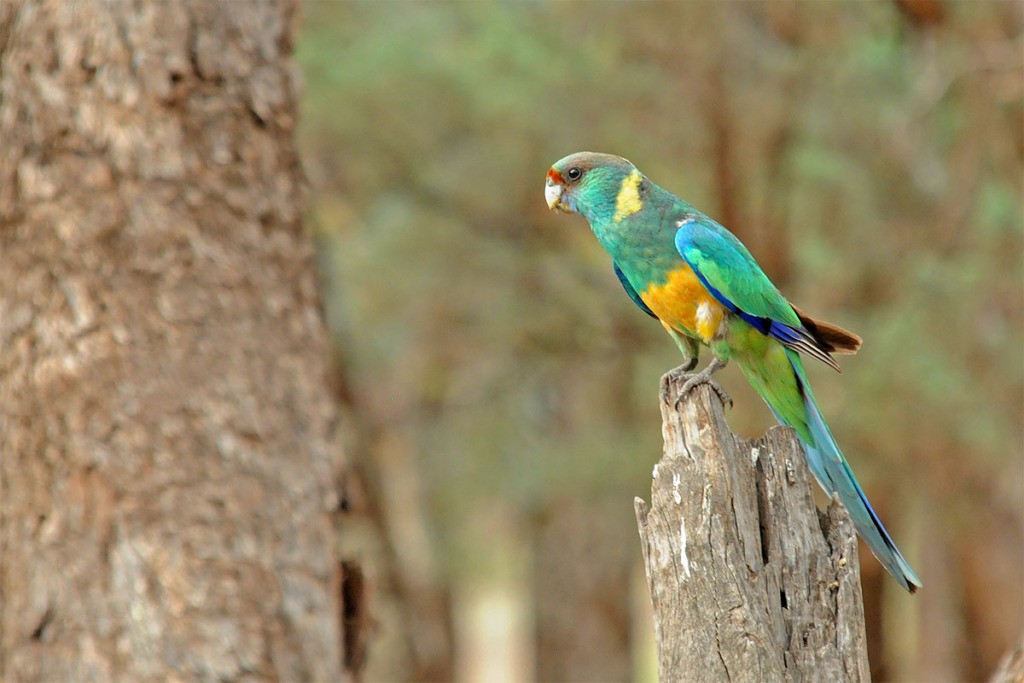
The Australian Ringneck is widespread in the country’s interior, but it is often missing from the eastern states’ coastal regions. Its preferred habitats are eucalypt woods and watercourses bordered with eucalypts, where it feeds on insects, nectar, seeds, and fruit.
There are a lot of ringnecks in the Outback. The Wilpena Pound campsite in South Australia’s Flinders Ranges National Park is among the greatest spots I’ve discovered to see them.
Red-capped Parrot
- Latin name: Purpureicephalus spurius
- Conservation Status: Least Concern
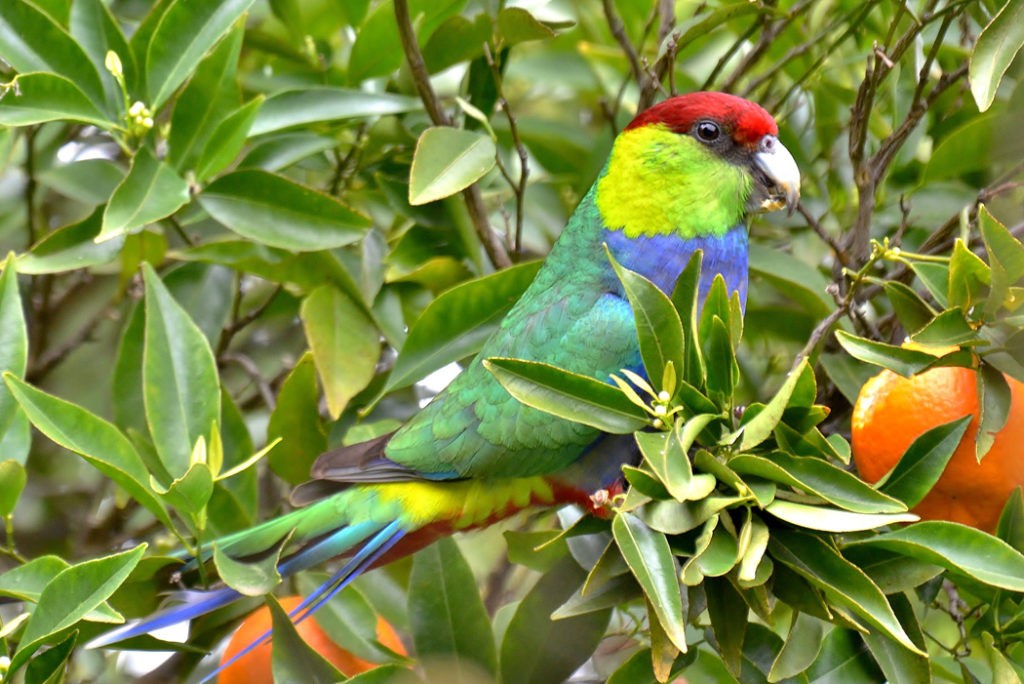
The Red-capped parrot, which may be easily recognized by its red crown, is native to Southwest Australia, namely to the woods, forests, and open savanna between Perth and Esperance. It is a sedentary species that mostly consumes berries, seeds, and flowers, with the occasional bug.
Bluebonnet
- Latin name: Northiella haematogaster
- Conservation Status: Least Concern

The Bluebonnet is a native of dry and semi-arid regions in southern Queensland, New South Wales, Victoria, and southwest Western Australia. It inhabits wide plains and the bushes of saltbush or bluebush, where it feeds on insects, seeds, fruit, and nectar.
Blu bonnets typically travel in couples or small groups when foraging on the ground. Additionally, they can form mixed flocks with other parrot species, such as the Mulga Parrot and the Australian Ringneck.
Swift Parrot
- Latin name: Lathamus discolor
- Conservation Status: Critically Endangered

One of Australia’s most endangered parrot species is the swift parrot. Swift Parrots are among the rarest Australian parrots; it is thought that there are just 2000 of them remaining in South-Eastern Australia.
This lovely parrot spends the summer months breeding in Tasmania and the winter months migrating to the mainland. Ironically, the Sugar Glider, one of Australia’s prettiest possums, is thought to be the main threat to its existence (aside from habitat degradation).
Red-rumped Parrot
- Latin name: Psephotus haematonotus
- Conservation Status: Least Concerned
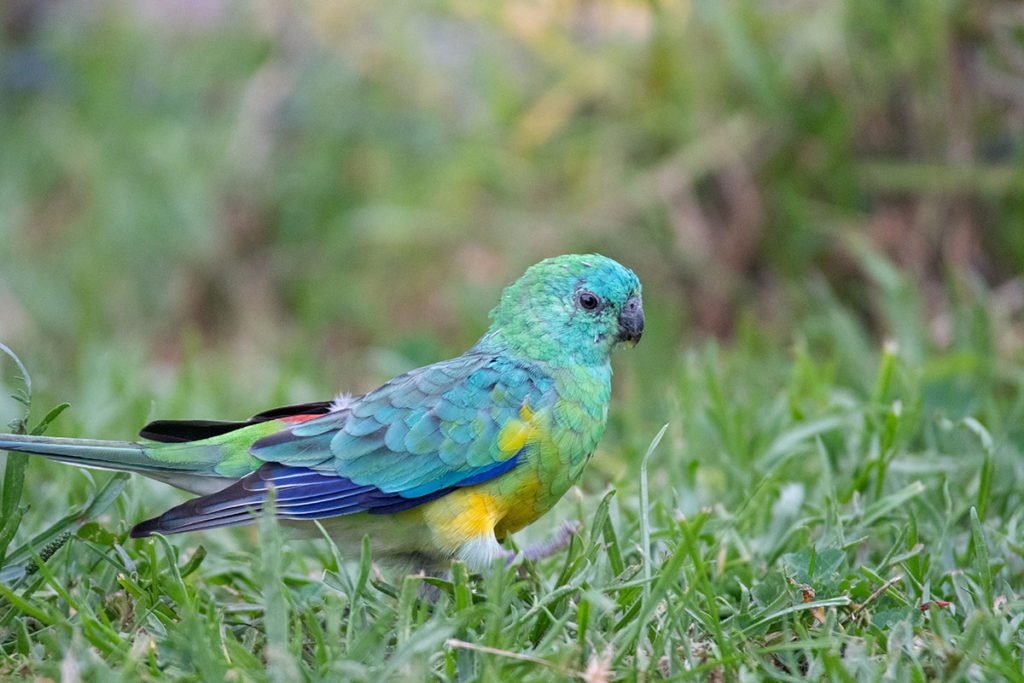
The Red-rumped Parrot is found in sections of South Australia, southwest Queensland, southeast Australia, and the majority of New South Wales. These charming parrots find lifelong partners.
Usually seen in feeding groups amid the galas and rosellas, they graze in couples or small flocks. Mount Annan Botanic Gardens is a fantastic spot in Sydney to watch Red-rumped parrots. They are frequently spotted in Sydney Olympic Park as well.
Mulga Parrot
- Latin name: Psephotellus varius
- Conservation Status: Least Concern

In the interior of southern Australia, from western New South Wales to central Western Australia, mulga parrots may be found in dry scrublands and forested grasslands.
They eat seeds, flowers, and insect larvae, just like the majority of little Australian parrots. They travel in tiny family groups or in pairs.
They have only ever spotted Mulga parrots once, while conducting a wildlife survey on the Eyre Peninsula.
Golden-shouldered Parrot
- Latin name: Psephotellus chrysopterygius
- Conservation Status: Endangered
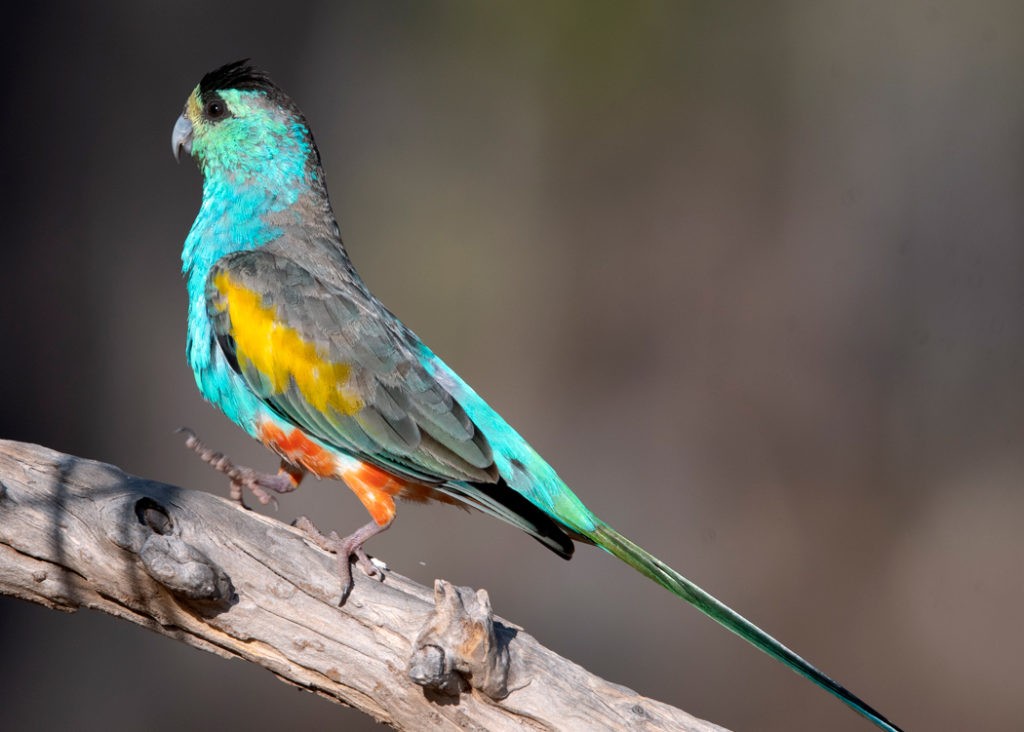
The Golden-shouldered parrot, which is indigenous to Queensland’s southern Cape York Peninsula, is distinctive in that it builds its nests in termite mounds. These magnificent birds burrow tunnels into the side of termite mounds, where they construct their nests.
They eat largely grass seeds, and for a few months of the year, firegrass seeds make up nearly all of their diet.
Due to its need on firegrass and termites, the Golden-shouldered parrot is extremely susceptible to habitat loss.
Hooded Parrot
- Latin name: Psephotellus dissimilis
- Conservation Status: Least Concern

The Hooded parrot, a near cousin of the Goulden-shouldered parrot, inhabits the Northern Territory’s semi-arid and desert regions. These parrots construct their nests in termite mounds, just like their golden-shouldered cousins.
They are seen living among rivers in eucalyptus, melaleuca, and grasslands woods where they graze for berries, fruit, and seeds.
Paradise Parrot
- Latin name: Psephotellus pulcherrimus
- Conservation Status: Most likely Extinct

Regretfully, the IUCN has declared the paradise parrot to be the only parrot in Australia to be “extinct.”
It was found in the grassland woodland regions of New South Wales and Queensland. Although sightings were very regular in the past, none have occurred since 1927.
Tasman Parakeet
- Latin name: Cyanoramphus cookii
- Conservation Status: Endangered
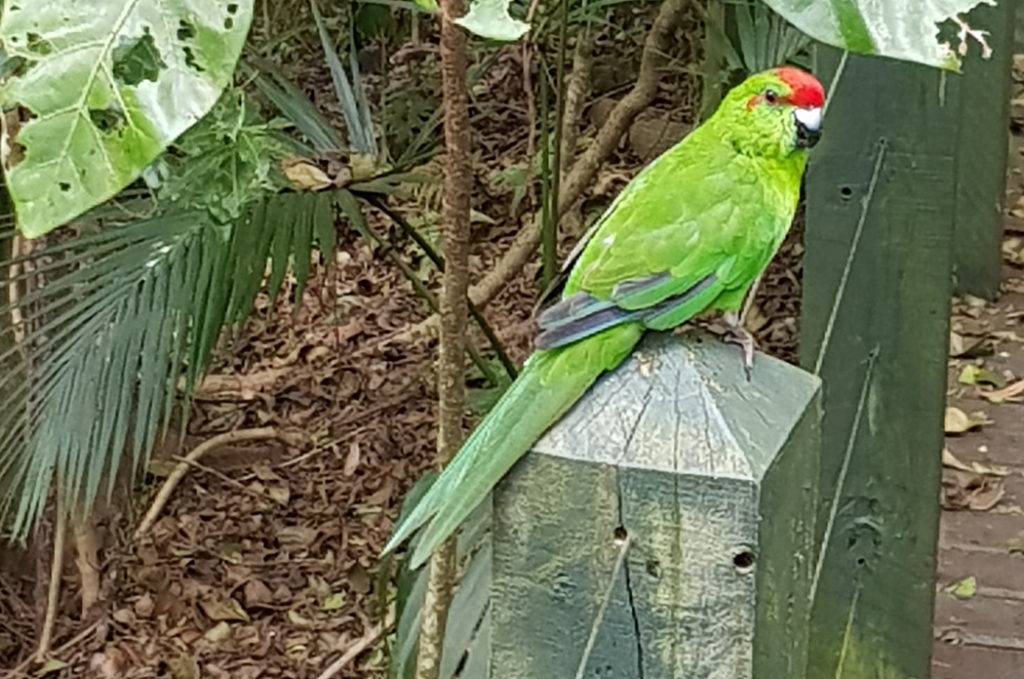
Since this parrot is native to Norfolk Island, its other name, Norfolk parakeet, is far more appropriate. And with the exception of Norfolk Island National Park, it has disappeared from most of the island.
Living in rainforests, Norfolk parakeets can visit nearby farms and orchards. Primarily, they consume seeds, although they also consume fruit, berries, and insects.
Red-crowned Parakeet
- Latin name: Cyanoramphus novaezelandiae
- Conservation Status: Extinct in Australia
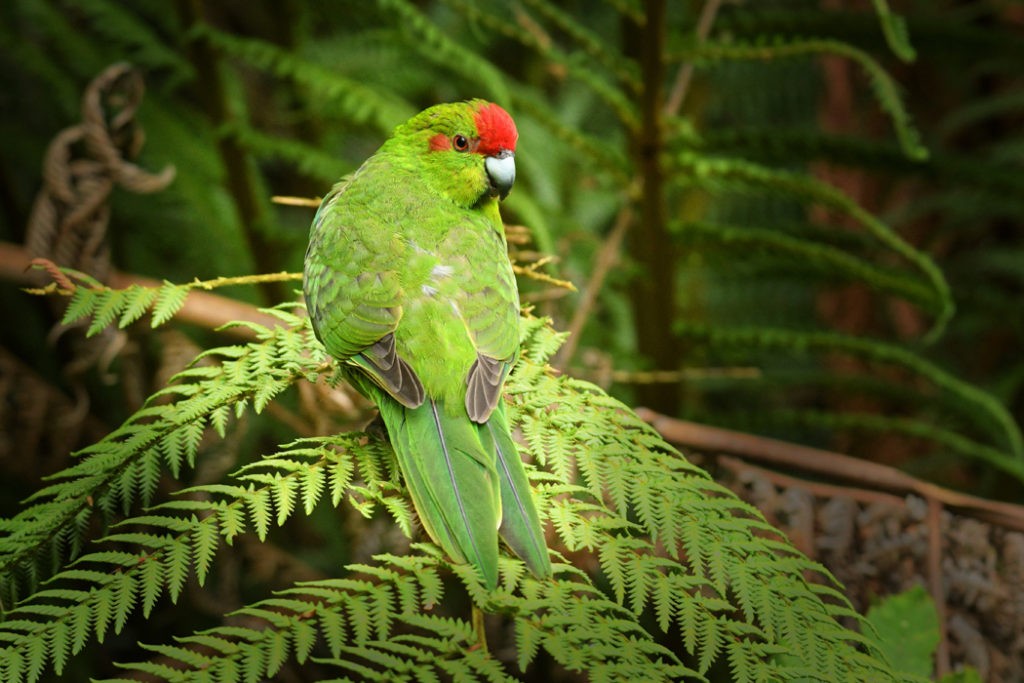
The Red-fronted Parakeet is primarily a species of parrot found in New Zealand, although it was formerly endemic to Lord Howe Island, where the Lord Howe Red-fronted Parakeet was last seen in 1869.
Bourke’s Parrot
- Latin name: Neopsephotus bourkii
- Conservation Status: Least Concern
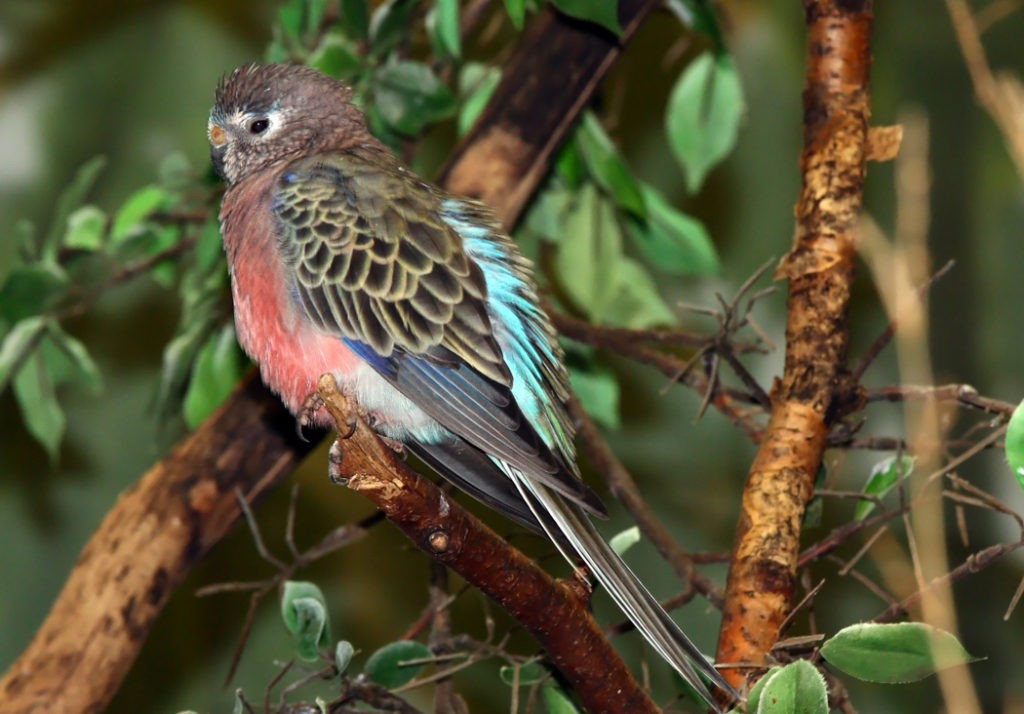
Burke’s parrot feathers are more muted, with a preponderance of gray tones, as compared to other Australian parrot species. This species is found across Australia’s dry and semi-arid regions, where it is always moving in search of food and water. Its preferred habitats are open woods, mulga and acacia scrubs, where it feeds on grass and plant seeds. Thus, it is primarily found on the ground.
Burke’s parrots frequently gather around water sources at dawn and dusk, and it’s not unusual to observe flocks of hundreds of birds during a drought.
Blue-winged Parrot
- Latin name: Neophema chrysostoma
- Conservation Status: Least Concern

The Blue-winged parrot is among the lesser-known parrot species in Australia. After mating in Tasmania, the majority of blue wings move to the mainland, however some remain. The majority of them go between southern Victoria and central and eastern Tasmania. Additionally, certain populations can be found in eastern South Australia and western New South Wales.
They may be found in many different types of environments, mostly using grass and plant seeds as food. They are frequently encountered on the ground and move in couples or small groups.
Elegant Parrot
- Latin name: Neophema elegans
- Conservation Status: Least Concern

The Elegant parrot is found in two different areas: the southeast, which stretches from western Victoria and southern New South Wales to eastern South Australia, the Flinders Ranges, and the Eyre Peninsula, and the southwest portion of Western Australia.
This species is migratory and prefers environments such as saline marshes, mallee, mulga, and open woods where they may gather grass and shrub seeds. On occasion, one may even spot them in agricultural areas. The most of the time, they forage on the ground, occasionally with other Blue-winged parrots.
Rock Parrot
- Latin name: Neophema petrophila
- Conservation Status: Least Concern

Only the southern coastline of Australia, extending from South Australia to Western Australia, is home to the rock parrot. It is often found on sandy beaches or rocky shorelines within 100 meters of the coast. When they get together in mixed flocks with Elegant Parrots and Blue-winged Parrots that seem similar, it might be difficult to tell them apart.
These parrots often forage in the early morning and late afternoon, where they consume seeds and fruits. Early in the morning, I witnessed Rock parrots foraging along the rocky coastline in the seaside village of Elliston.
Orange-bellied Parrot
- Latin name: Neophema chrysogaster
- Conservation Status: Critically Endangered
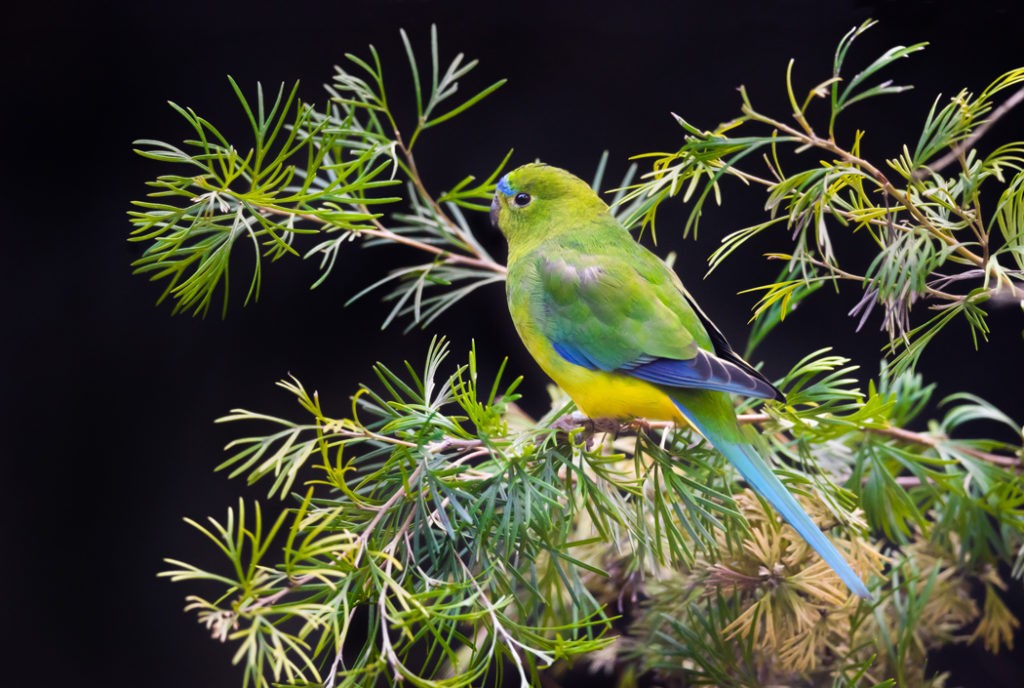
With just 118 birds confirmed in 2023, the orange-bellied parrot is among Australia’s most vulnerable parrot species. Only three parrot species in Australia migrate: the blue-winged parrot, the swift parrot, and this one. In the winter, they move to the coast of southern mainland Australia from their distant breeding grounds in southwest Tasmania.
They are found nearly entirely along the shore, where they feed on the seeds of salt marsh plants. These parrots often feed on the ground in couples or small flocks and mate for life.
Turquoise Parrot
- Latin name: Neophema pulchella
- Conservation Status: Least Concern
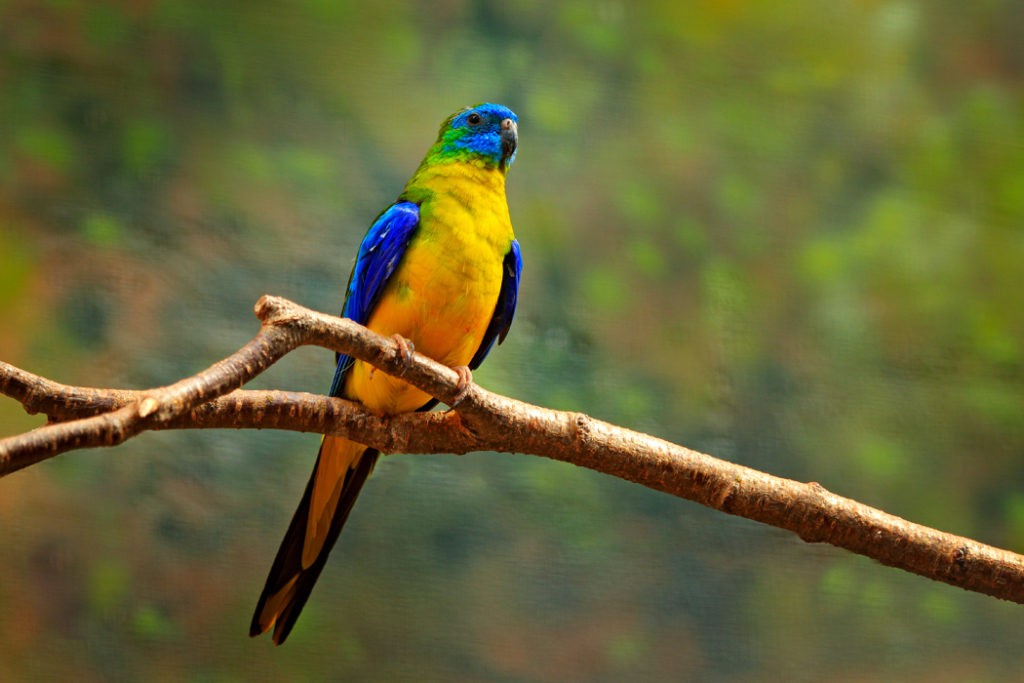
Eastern Australia is home to the turquoise parrot, which may be found from northeastern Victoria to New South Wales and southeast Queensland. These parrots are more at home in open woodland and savanna settings, where they mostly eat insects, seeds, fruit, nectar, and flowers.
They travel in couples or small family groups most of the time, although they can occasionally gather in big flocks made up primarily of young birds.
Scarlet-chested Parrot
- Latin name: Neophema splendida
- Conservation Status: Least Concern
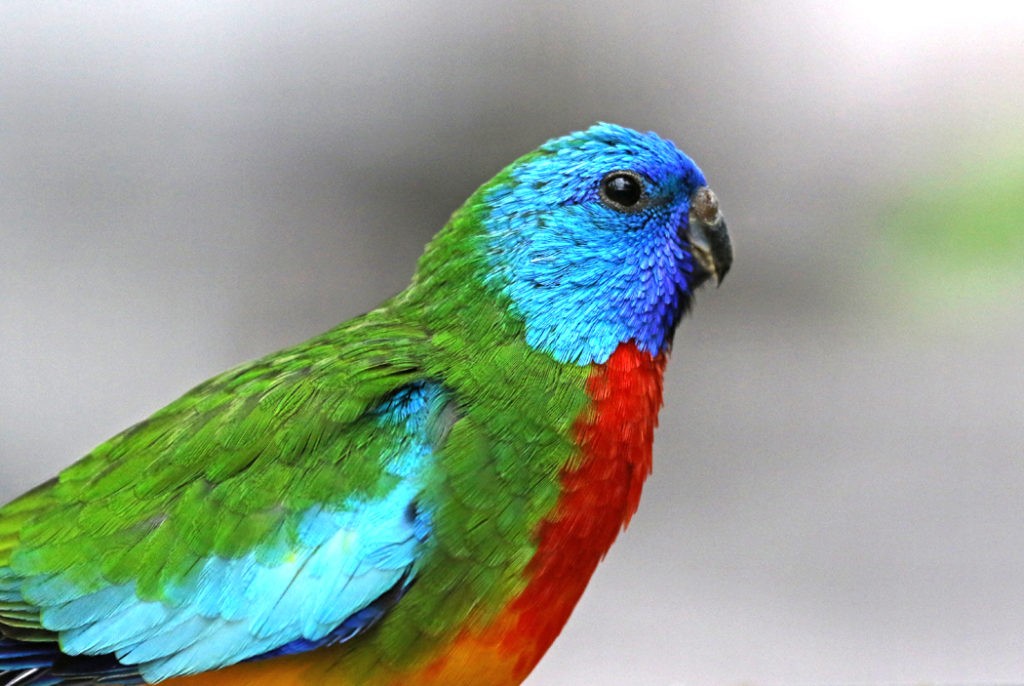
In southern Australia’s dry and semi-arid areas, the infrequently seen Scarlet-chested parrots are often found in open forests with saltbush, mulga with spinifex, eucalypts, and she-oak. It is mainly found on the ground or low in the bushes since it feeds on grass seeds.
Experts surmise that because they are usually found distant from water supplies, they are able to get enough fluids from eating succulent plants.
Although they often congregate in small groups, bigger flocks have sometimes been spotted. At the Scotia Wildlife Sanctuary in western New South Wales, I have spotted a solitary female Scarlet-chested parrot.
Eastern Ground Parrot
- Latin name: Pezoporus wallicus
- Conservation Status: Least Concern
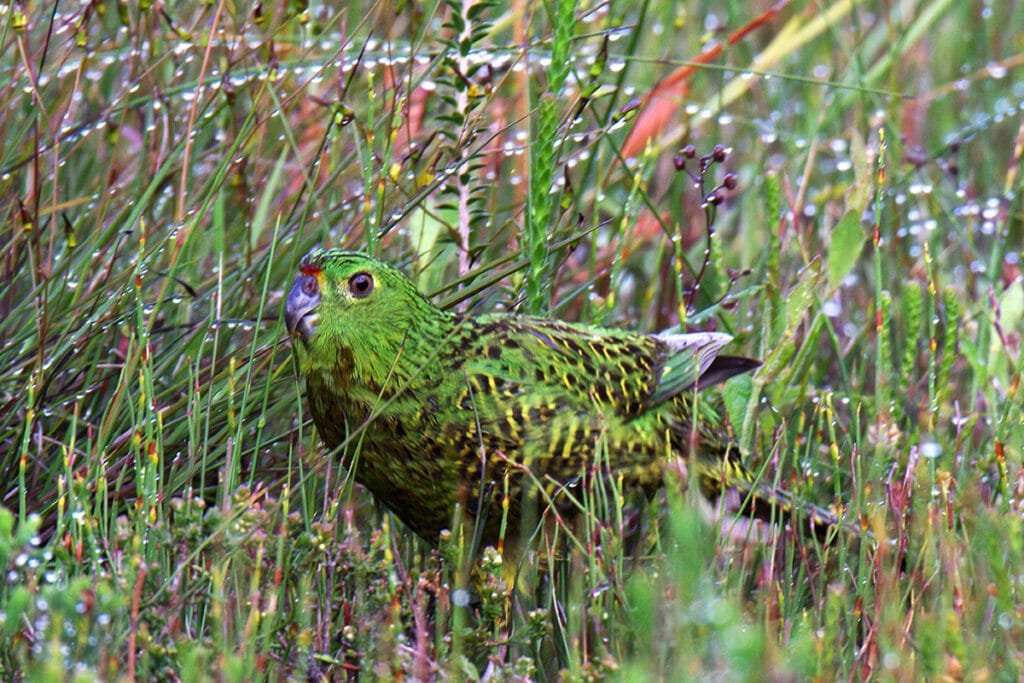
The eastern coast of Australia is home to the Ground parrot, which is dispersed over the region from southeast Queensland to the coastal regions of Gippsland in Victoria and Tasmania. This parrot is mostly found in thick coastal environments such as buttongrass plains and heathlands, where it feeds on grass and shrub seeds.
The Southern Highlands of NSW’s Barren Grounds Nature Reserve is a wonderful area to look for Eastern Ground Parrots.
Western Ground Parrot
- Latin name: Pezoporus flaviventris
- Conservation Status: Not assessed by IUCN yet. Australia’s Critically Endangered
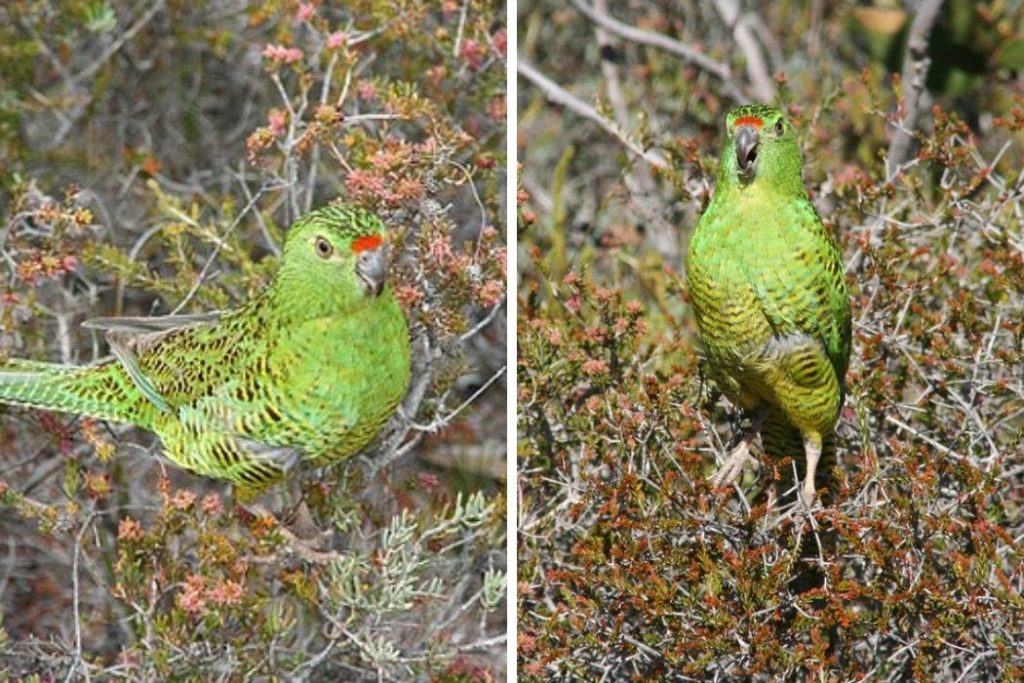
One of the rarest parrots in the world is the Western Ground Parrot, a near cousin of the Eastern Ground Parrot. There are just about 150 birds left in the wild in Western Australia. The species is mostly found in a secluded national park; nevertheless, in order to protect the population from wildfires, a small number of birds were relocated from Cape Arid to a region east of Albany in 2021–2023.
Night Parrot
- Latin name: Pezoporus occidentalis
- Conservation Status: Endangered

For naturalists and birdwatchers, the Night Parrot—once believed to be extinct—is frequently regarded as the “holy grail.” Experts believe that there are between 50 and 249 adult Night parrots living in dispersed communities throughout Australia’s interior areas, while accurate population estimates are unknown.
My introduction to Australian parrots comes to an end here. They are an incredibly varied group of birds, and for me, seeing them in the wild is always the high point of any wildlife exploration.
In Australia, how many parrots have you seen?
Feel free to share your thoughts and suggestions in the comments section provided.
